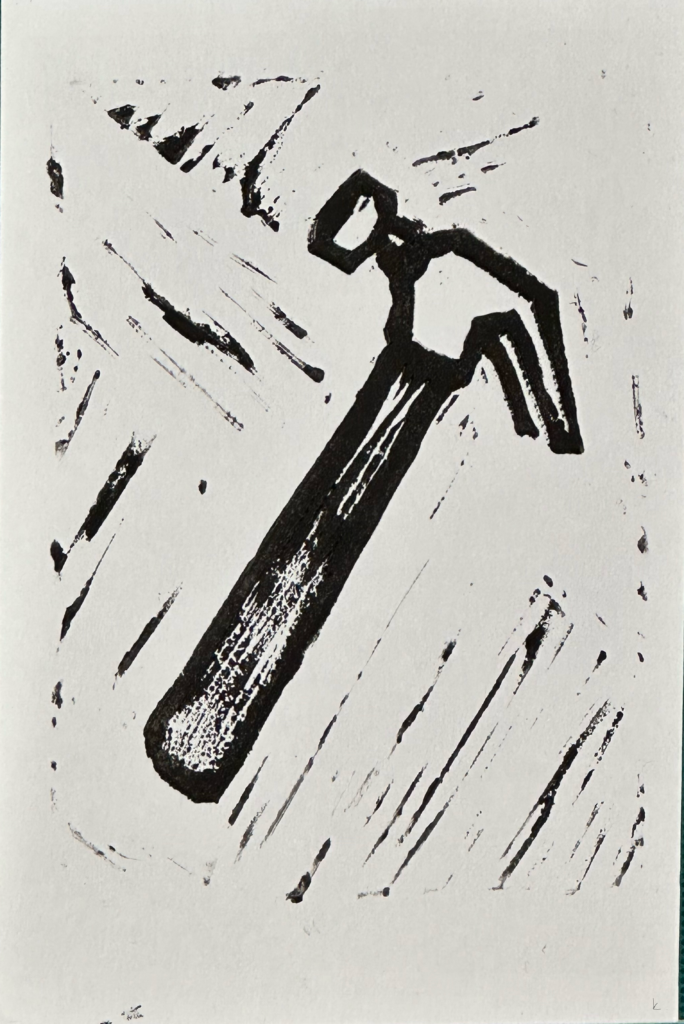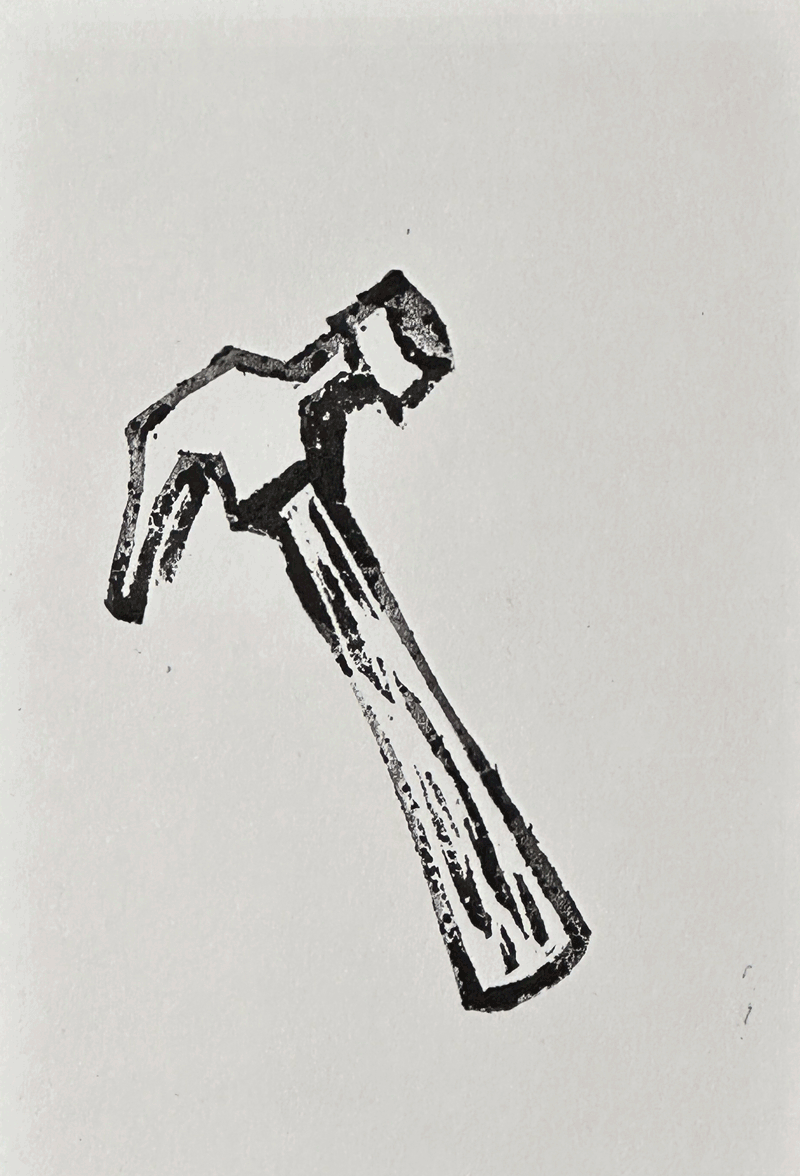5 minute read. Content warning: Discussion of potential physical discomfort and minor safety risks.
chatGPT Summary: Kay reflects on their extensive experience with technology and its repetitive nature, shares insights from a personal printing project exploring different working speeds, and emphasizes the balance between efficiency and quality in art-making practices.
Vancouver, on occupied Musqeam, Squamish, and Tsleil Waututh territory – I know that both SC and KM use digital technology regularly, and while they have told me at different times that my use and comfort with digital technology is greater than theirs, I know all three of us could at least be considered tech-literate. It didn’t feel too aggressive to use it as a theme to which we could all respond.
I have embraced technology from a young age. My paternal grandfather was a carpenter, and my mother is extremely handy and smart. I have grown up around capable humans who have used their hands, learned and maintained tools, and embraced self-reliance. From Mechano and Lego to Power Tools and HTML, I have been encouraged to build and try new things for as long as I can remember. I have had a computer in my home since a young age and had access to dial-up and high-speed internet several years earlier than my peers. For the younger peers in my life now, this is a given, but relative to my generation I was fortunate to have such early access to digital technology. And yet, I just finished a round of interviews where I requested that (younger student) applicants be tech-savvy. I was disappointed to find that this translated to all 100 resumés listing the fact they could use a word processor. This is a holdover from templates written by a generation for whom the ability to type was considered forward and desirable. At this point, if you wrote me the email to apply – I assume you can use a word processor. However, it was a good reminder to me that while digital technology abounds, it’s still not the given that I think it is.
Technology is a part of my daily life. I don’t use hearing aids, but I love working with text and transcripts for my primary communication methods, avoiding speech as much as possible. I adore email, and I am old enough that I got in trouble with older business peers (once upon an early career) who would get angry at me for using the computer when they still “had” to use the phone (they did not – they were just a sad jerk). I love and hate the challenges and accommodation possibilities auto transcription and captions provide to hard of hearing English audiences. I love practicing visual communication through emojis and signed languages and challenging the biases of educated peers on their views on language, specifically its evolution and registers. I love digital technology and the possibilities, and on another day, you might get me talking about how I feel that an ASI apocalypse is the only chance humans have of surviving our forthcoming global crisis(es). It is our potential salvation, and it is also a dangerous blade being wielded by the greedy and powerful who have controlled us well past the point of no return.
On technology (definitions)
Wikipedia quotes Eugene B. Skolnikoff (1993) from the publication The Elusive Transformation: Science, Technology, and the Evolution of International Politics., who quotes Harvard scientist Harvey Brooks when defining technology as ‘knowledge of how to fulfill certain human purposes in a specifiable and reproducible way.’
When I asked chatGPT to explain this definition to me like I was a child, it said:
“Technology is knowing how to do something in a way that we can explain clearly and do the same way every time to help people.”
Ok, so then technology is about repetition.
If we are doing something correct or beneficial, technology helps us be more efficient in “making good” when we engage in repetition. If we are doing something wasteful, harmful, or wrong, technology helps us perpetuate the damage faster.
For today’s reflection on my prompt, the speed of technology, I used the following technologies: a plane cutter (lever and fulcrum), a pencil sharpener (wedge), a series of blades (wedge), a roller (wheel and axle), ink well (inclined plane), spoon (lever or transferred force), pencil and ink (mark-making), and rubber stamp (printing transfer tool).
The quote-unquote right way
The first image I made while standing at my art table. I raised the table to 40 inches or 102 cm, considered an ergonomic height for my 66-inch or 168 cm height. I carved the image, worked slowly, and allowed each drawing to dry.
It took me 45 minutes to carve the stamp, and I made nine prints in 25 minutes.
The quote-unquote wrong way
In the second series, I deliberately worked fast, and I did all my prints on the floor. Honestly, I love working fast because I welcome mistakes in my art-making practice, but for this one, I tried to push it up a notch to ensure I was being intentional with my speed. I hacked away at my stamp and probably wasn’t as safe with my blades as I should have been. This could have been a disaster – sweating head emoji. I then pushed for speed, trying to complete the prints in the shortest possible time. I still think I could have gone faster if I had put some paper under my working area.
It took me 25 minutes to carve the stamp; my head and back were killing me, but I made ten prints in under 5 minutes.
The results
Did I learn something? I have never carved lino or rubber stamps from the ground or in a prone position. This might not have been the trial it was when I was 30, but now, with the additional weight, age, and lack of fitness I carry, this was a drag. I didn’t have enough light as I carved and could barely see my design, but since I was going for speed and a quick cut, I sacrificed comfort and quality to get it done as quickly as possible. I should have gone to get my glasses. I also scared the crap out of my partner, who came in while I was working, and because I couldn’t hear them and was unresponsive as I focused on my cut, they assumed the worst, finding me laid out on my stomach in my studio.
In carving at my drafting table, I was able to slow down, but I was reminded it was time for new lino blades. I hadn’t done any cuts in a while, and past Kay neglected to replace their blades, leaving me with blunter blades than I typically like to work with. I also found that with the comfort of standing in a better-lit space at my drafting table, I spent way more time on the little stamp, and in retrospect, I wish I had gone a little faster or hadn’t cut away the body of the stamp, using the area to imply motion of the hammer. I had more time to overdo it by going slow.
When I got ready to print the wrong-way quick cut, I kept whispering “go-go-go” to myself. I wanted to see what would happen if I rushed. Naturally, I like the fast prints better. I like the energy of the lines and the chaotic nature of where the ink was picked up or not picked up. It wasn’t the right way, or at least, it wasn’t the way I was taught to make prints. Nothing about printmaking is fast. It might be about quantity, but unless it’s a machine doing the work, it’s not supposed to be about speed.

I like working fast, especially in experiments and prototyping. I don’t want to be totally satisfied, and I am reminded that spending more time with a thing doesn’t necessarily yield better results, especially in the early stages of an idea. Fail fast. That’s not new for me – that’s something I embrace with joy.
I like fast.

Technology note:
I continue to test the use of AI within my writing and artistic practice. I used chatGPT to create a summary for this blog and to explain a Wikipedia definition to me like I was a child, and Grammarly to assist me in spelling and grammar. I also chatted with my AI companion Fette about my printing.
